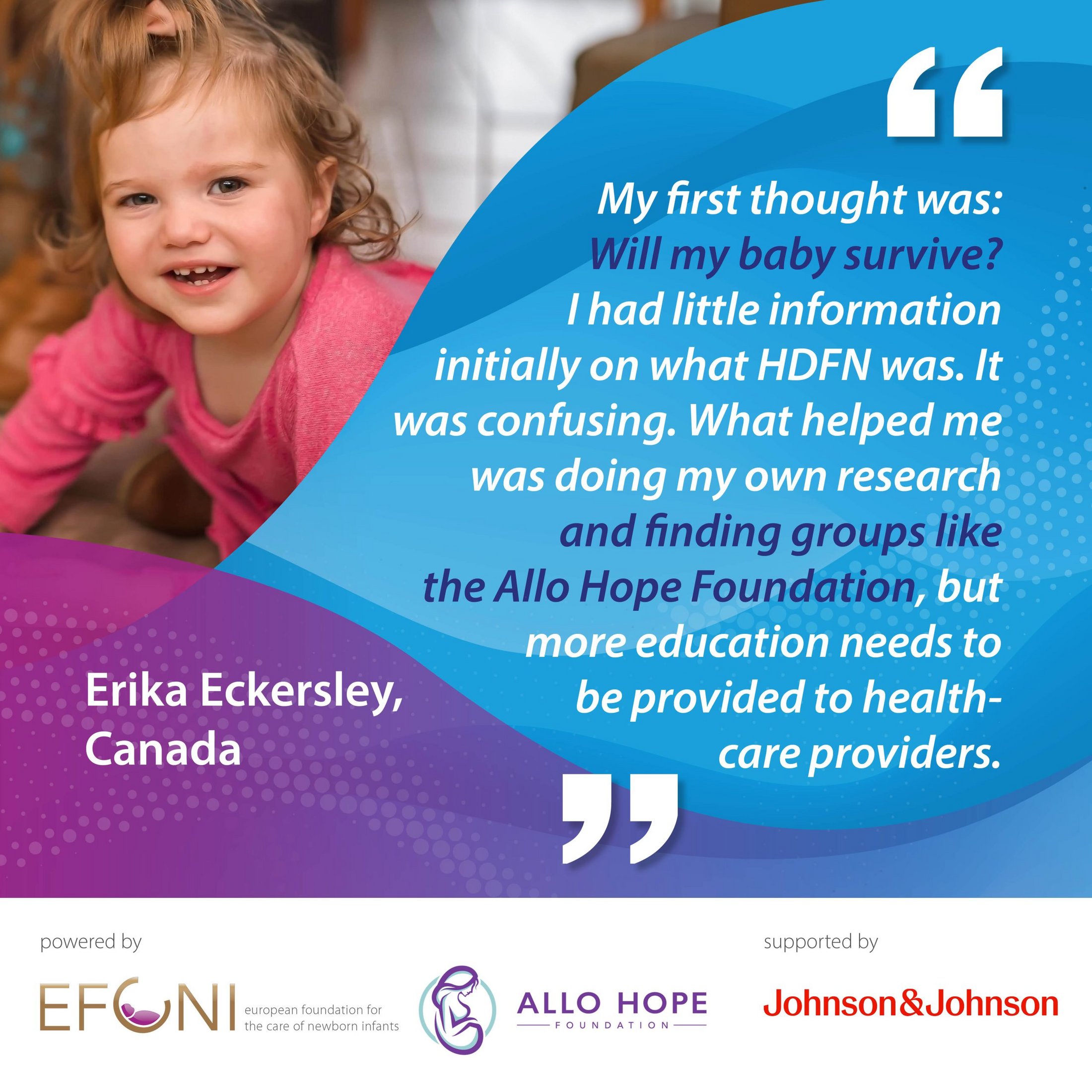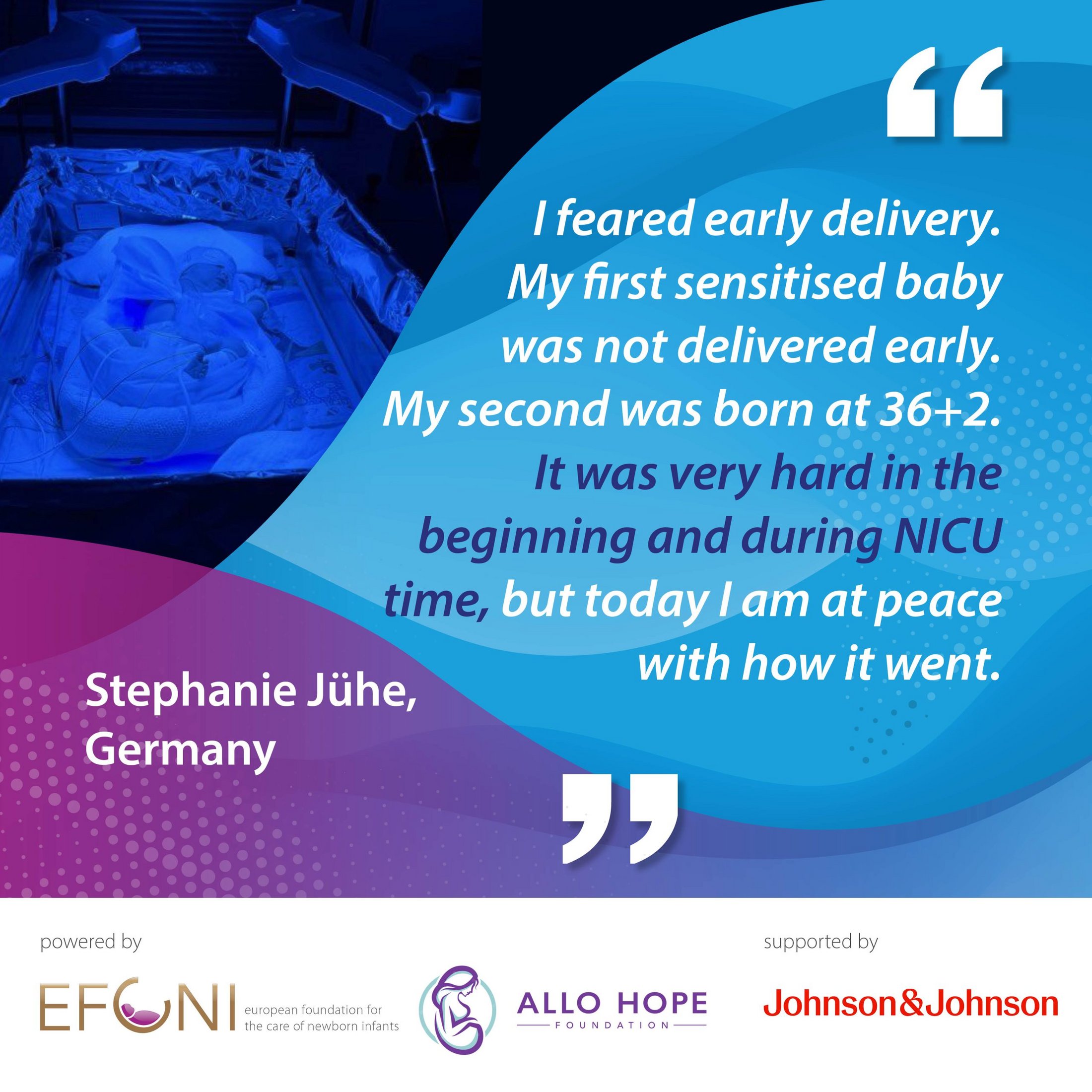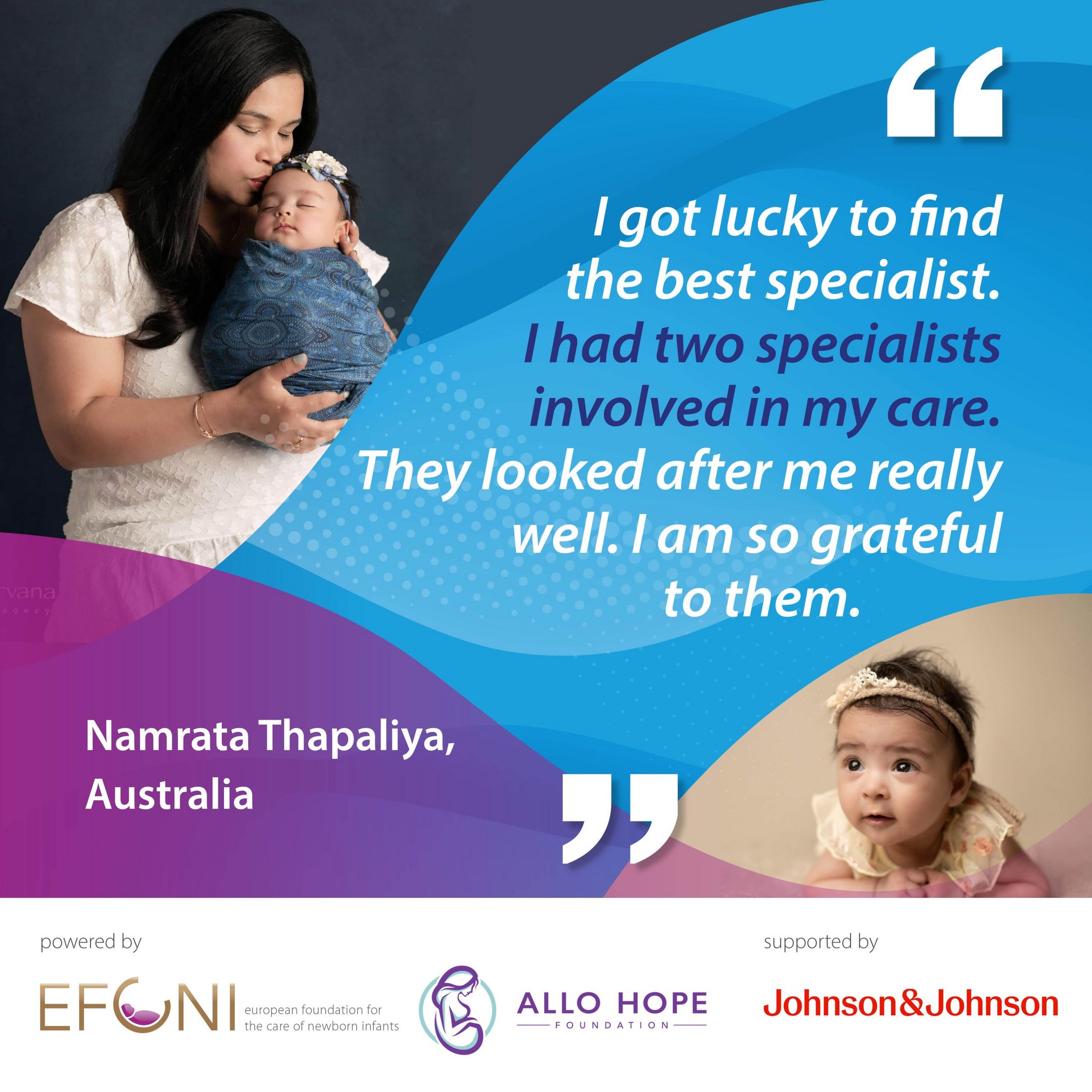Pregnancy Complications
Infant- and Family-Centered Developmental Care
Respiratory Infections
Neonatal Eye Health
Hygiene
Rare Diseases
Hemolytic Disease of the Fetus and Newborn (HDFN) is a rare but serious condition that can occur during pregnancy when a mother’s immune system attacks her baby’s red blood cells. This campaign page explains what HDFN is, how it’s diagnosed and managed, and why early detection and specialist care are essential. Explore expert insights, patient stories, and practical resources to raise awareness and support families affected by HDFN.

Did you know that rare diseases can also affect pregnancy? Some conditions can impact the developing baby (fetus) while still in the womb—one of these is Hemolytic Disease of the Fetus and Newborn (HDFN).
HDFN occurs when a mother’s red blood cells are incompatible with those of her baby. While it’s common for a mother and baby to have different blood types, problems arise in rare cases where the maternal immune system reacts to the baby’s red blood cells as if they were foreign. This immune response—called maternal alloimmunization—leads the mother to produce antibodies that attack the baby’s red blood cells, causing them to break down rapidly. As a result, the baby can develop fetal anemia.
Fetal anemia increases the risk of preterm birth and may lead to other complications, such as jaundice after birth and excess fluid in the fetus’s organs. Once sensitized, the mother’s immune system retains the antibodies, making future pregnancies at even higher risk, with potentially more severe outcomes.
The good news is that HDFN can be managed if diagnosed early in pregnancy. Pregnant women who are at risk should be referred to a specialist team for monitoring and care. Awareness is the first step—understanding the condition and asking for specialist care can significantly improve health outcomes for both mother and baby.

Screening for Hemolytic Disease of the Fetus and Newborn (HDFN)
HDFN is a rare but serious pregnancy condition that occurs when the mother’s red blood cells are incompatible with those of her unborn baby. In these cases, the mother’s immune system may recognize the baby’s red blood cells as foreign and produce antibodies to attack them. This immune response can lead to fetal anemia, a condition where the fetus has lower-than-normal levels of red blood cells and hemoglobin.
Red blood cells are essential for carrying oxygen to the baby’s developing tissues and organs. When fetal anemia occurs, it can lead to heart complications and other serious health risks.
How Is the Risk of HDFN Identified?
The risk of HDFN can usually be detected early through routine blood screening. There are many blood group systems, with ABO and Rhesus (Rh) being the most well-known. Incompatibilities in these and other systems can trigger HDFN.
At the start of every pregnancy, all women should have their blood group and antibody status tested.
If there is a potential incompatibility, non-invasive fetal genotyping—using a simple maternal blood sample—can help confirm the baby’s blood type. Paternal testing may also be done to assess the likelihood and severity of incompatibility. These tests help determine the specific antibodies involved and guide the care plan throughout the pregnancy.
Ongoing Monitoring and Specialist Care
If the mother is producing antibodies against the baby’s red blood cells, healthcare providers will regularly monitor antibody levels (titers) to assess the level of risk. With continued exposure between the baby’s and mother’s blood, these antibody levels may increase—a process known as sensitization.
Once sensitization has occurred, the mother’s immune system will respond more aggressively in future pregnancies, producing antibodies immediately. This makes early detection and expert care especially important—not only for the current pregnancy but also for any future ones.
Early referral to a specialist with experience in HDFN is essential to ensure accurate diagnosis, risk assessment, and close monitoring throughout the pregnancy.

Managing the Risk of Hemolytic Disease of the Fetus and Newborn (HDFN)
Hemolytic Disease of the Fetus and Newborn (HDFN) is a rare condition that occurs when a mother’s red blood cells are incompatible with those of her unborn baby. This incompatibility can lead to fetal anemia, where the baby has too few red blood cells to carry oxygen effectively throughout the body.
HDFN varies in severity—from mild cases to life-threatening complications. In the most severe forms, the condition can result in heart failure and fetal death.
Why Early Education and Prevention Matter
In many cases, the first pregnancy is not affected because the mother has not yet been exposed to the baby’s red blood cells. However, exposure often occurs during childbirth, when the mother and baby’s blood can mix. If the blood types are incompatible, the mother’s immune system may begin producing antibodies that attack fetal red blood cells in future pregnancies. This process is called sensitization and can lead to increasingly severe outcomes.
Because of this, it is crucial to educate women early—starting in their first pregnancy—about the risks of HDFN. For women with RhD incompatibility, preventive therapy (such as anti-D immunoglobulin) can be administered to stop the immune system from forming these harmful antibodies.
What Factors Influence HDFN Severity?
Several factors can affect how severe HDFN becomes:
Monitoring and Specialist Care
Managing HDFN effectively requires ongoing monitoring and expert care. Key steps include:
Early detection and intervention can improve outcomes and reduce complications. If HDFN is suspected or confirmed, care should always be coordinated by a team of experienced specialists.
| Term | Explanation |
|---|---|
| Administered | Given or applied, typically referring to a medication or treatment. |
| Anemia | A condition where the number of red blood cells or the level of hemoglobin is too low, reducing the blood’s ability to carry oxygen. |
| Antibody | A protein produced by the immune system to identify and attack foreign substances in the body. |
| Antibody titer | A test that measures the level of antibodies in the blood. |
| Blood type | Also called a blood group; refers to specific markers on the surface of red blood cells that vary from person to person. |
| Compatible | A match between two substances or systems that allows them to coexist or function together without adverse reaction. |
| Doppler | A medical imaging technique that uses sound waves to measure blood flow in vessels. |
| Exposure | Contact with a substance, such as fetal blood cells entering the mother’s bloodstream. |
| Fetal | Relating to the fetus (unborn baby). |
| Fetus | An unborn baby developing in the womb. |
| Genotyping | A process that analyzes a person’s genetic makeup to understand traits or disease risks, often using a simple blood test. |
| Hemoglobin | A protein in red blood cells responsible for transporting oxygen and carbon dioxide throughout the body. |
| Hemolytic | Referring to the destruction or breakdown of red blood cells. |
| Incompatibility | A condition where two substances (such as maternal and fetal blood types) cannot coexist without causing a reaction. |
| Jaundice | A yellowing of the skin and eyes caused by a buildup of bilirubin, often due to the breakdown of red blood cells. |
| Maternal alloimmunization | A process in which a pregnant woman’s immune system produces antibodies (alloantibodies) against her baby’s red blood cells. |
| Middle cerebral artery (MCA) | A major artery in the brain; Doppler ultrasound can assess its blood flow to detect fetal anemia. |
| Non-invasive | A procedure that does not involve breaking the skin or entering the body. |
| Paternal | Relating to the father. |
| Premature / Preterm birth | The birth of a baby before 37 weeks of pregnancy. |
| Preventive | Actions or treatments intended to stop a disease or condition from occurring or worsening. |
| RhD | A protein (D antigen) found on red blood cells; its presence or absence determines Rh compatibility. |
| Sensitization | When the immune system becomes reactive to a specific substance; in HDFN, this means the mother's immune system recognizes and reacts to the baby’s red blood cells. |
| Severity | The seriousness or intensity of a condition or its symptoms. |
| Ultrasound | A diagnostic tool that uses high-frequency sound waves to create images of the fetus and internal organs. |
Meet Carrie Yavuz, an educational psychologist and a bereaved mother. In this deeply personal testimonial, she shares her HDFN journey — a story marked by loss, grief, and ultimately, hope.
Drawing from her personal experience, she highlights the emotional toll HDFN can take on families while offering encouragement and guidance. She emphasizes the importance of awareness, advocacy, and timely specialist care so parents feel empowered to achieve the best possible outcomes for their babies.
Watch her statement to understand the impact of HDFN from a family's perspective.
We spoke with Bethany Weathersby, founder and executive director of the Allo Hope Foundation, about what HDFN means for families and why raising awareness of this rare condition is so critical.
Bethany shares a powerful and hopeful message for parents: with early detection, close monitoring, and specialist care, HDFN can be successfully managed—and babies can go on to live healthy, thriving lives. That’s why awareness is vital.
Watch her statement to learn how parents can advocate for their baby and help ensure the best possible care.
What does expert care for HDFN look like? What monitoring is needed before and after birth? And what is the long-term outlook for babies affected by HDFN?
We sat down with Professor Stefan Verlohren, Director of the Department of Obstetrics and Fetal Medicine at University Medical Center Hamburg-Eppendorf (UKE), Germany, to explore these key questions.

Erika from Canada shares her personal experience following her HDFN diagnosis and how it has shaped her journey. Today, she advocates for better education and awareness of HDFN among healthcare providers.
“My first thought when I received the diagnosis was: Will my baby survive all of this? I had little information at first about what HDFN was, aside from being told it was incredibly rare and would cause anemia requiring transfusions. It was confusing and overwhelming to understand.”
Hemolytic Disease of the Fetus and Newborn (HDFN) is a rare condition, affecting only 2.5 per 100,000 births in high-income countries. As a result, many primary healthcare providers may have limited knowledge or experience with HDFN, having seen very few—if any—patients with the condition.
“What helped was doing my own research and finding supportive organizations like the Allo Hope Foundation. But more education needs to be provided to healthcare providers.”
Thank you, Erika, for sharing your story. Your voice sheds light on the urgent need for improved education and support—for both patients and healthcare professionals—when it comes to rare conditions like HDFN.

Stephanie from Germany shares her personal journey with HDFN and how, despite the challenges, she found peace, strength, and hope.
As is often the case with Hemolytic Disease of the Fetus and Newborn (HDFN), Stephanie’s alloantibodies were first detected during her second pregnancy:
“I was diagnosed after my first birth, at the beginning of my second pregnancy. I felt afraid and helpless, and especially uninformed about the risks and possible treatments.”
The Search for Specialist Care
After learning about her diagnosis, Stephanie understood the importance of finding expert care—but the journey wasn’t easy:
“I did seek specialist care after my diagnosis. But my local gynecologist wasn’t able to help much. I had to do a lot of research myself to find a specialist in this field. It was quite difficult—and the specialist was a four-hour drive away.”
Facing Early Delivery: From Fear to Peace
Stephanie feared the risks associated with preterm birth, a common concern for HDFN pregnancies. Fortunately, her experience had a hopeful outcome:
“Yes, I feared early delivery. My first sensitized baby wasn’t delivered early. My second was born at 36+2, induced at 36+0. It was very hard at first and during the NICU stay, but today—three months later—I feel at peace with how it went. Compared to other serious conditions, it really wasn’t that bad.”
Choosing to Grow Her Family
After her diagnosis, Stephanie and her partner took time to consider their next steps. They ultimately chose to move forward with hope:
“Yes, I wanted more babies. After the diagnosis, we waited a year to reflect and inform ourselves before making a decision. We still had concerns, but we took the risk—and we’re so glad we did.”
Thank you, Stephanie, for sharing your story of courage, resilience, and hope. Your experience highlights the importance of access to specialist care and empowers other families navigating the challenges of HDFN.

Namrata from Australia shares her deeply personal journey with HDFN, reflecting on her experiences, challenges, and the urgent need for greater awareness and education about this rare disease.
A Difficult Path to Diagnosis
Namrata’s alloantibodies went undetected during her first pregnancy. It wasn’t until her fourth pregnancy that she was fully informed about the severity of Hemolytic Disease of the Fetus and Newborn (HDFN):
“My first pregnancy ended in a stillbirth at 21 weeks. My antibodies were detected during my second pregnancy, which also ended as a stillbirth at 15 weeks. I didn’t have enough information about HDFN at the time. I only learned the full details during my fourth pregnancy, with Aavya. I was 17 weeks pregnant when I found out my daughter was already severely anemic.”
Namrata recalls a lack of guidance from her care team:
“My general practitioner and obstetrician never explained the severity of the condition. They only mentioned I had Kell antibodies—but didn’t explain how serious fetal anemia could be. There’s a big information gap. We need to spread awareness so new moms with antibodies get the information and support they need.”
Facing the Diagnosis: From Fear to Hope
Learning her baby was severely anemic left Namrata overwhelmed:
“I thought I would lose her. It felt like there was no light at the end of the tunnel. My doctor explained treatment options, but he also told me about the high risks associated with IPT and IUT* during early pregnancy. I lost hope and started preparing for the worst.”**
Support made all the difference:
“The Allo Hope Foundation gave me hope. I listened to their podcast throughout the night and read Facebook stories from other moms. I can’t thank them enough for giving me strength during the hardest time of my life.”
Specialist Care Changed Everything
After years of uncertainty, Namrata finally found the expert care she needed:
“I was lucky to find an excellent specialist—actually at the clinic where I had my routine ultrasounds. I had two incredible doctors, including one of Australia’s most experienced in IUTs. They looked after me so well. I’m truly grateful.”
Her story emphasizes how critical timely referral to specialists is for improving outcomes.
The NICU Journey: Anxiety and Resilience
Namrata feared the consequences of preterm delivery—and when it happened, the fear was overwhelming:
“Every IUT brought anxiety. At 31 weeks and 5 days, my baby had bradycardia during the procedure, and she had to be delivered. I was in shock. I kept thinking she was still in my tummy, even after she was in the NICU. I was constantly anxious. I dreaded answering phone calls from the hospital. Even now, I get scared easily. I live with the fear of losing her. I hope that feeling gets better with time.”
Looking Ahead: A Heart Divided
The emotional toll of her experience has made Namrata cautious about the future:
“I still haven’t decided if I want to have another baby. I’m afraid of another preterm birth and spending a long time in the hospital again. I don’t know if I have the strength to go through the risks of IUTs again.”
Thank you, Namrata, for sharing your powerful story. Your voice brings visibility to the lived experience of HDFN and highlights the importance of awareness, specialist care, and emotional support for families facing this rare condition.
Glossary:
IPT = Intrauterine peritoneal transfusion – A procedure in which red blood cells are injected into the baby’s abdomen to treat early severe anemia.
IUT = Intrauterine transfusion – A life-saving procedure where red blood cells are delivered directly to the baby through the umbilical cord or abdomen to treat fetal anemia.
All content in the “HDFN Is Rare - Be Aware - Ask for Specialist Care” campaign was independently developed by GFCNI and reviewed by external experts for medical accuracy. The campaign is powered by GFCNI.

GFCNI sincerely thanks The Allo Hope Foundation for their strong support and valued collaboration.
© 2025 GFCNI. All Rights Reserved.